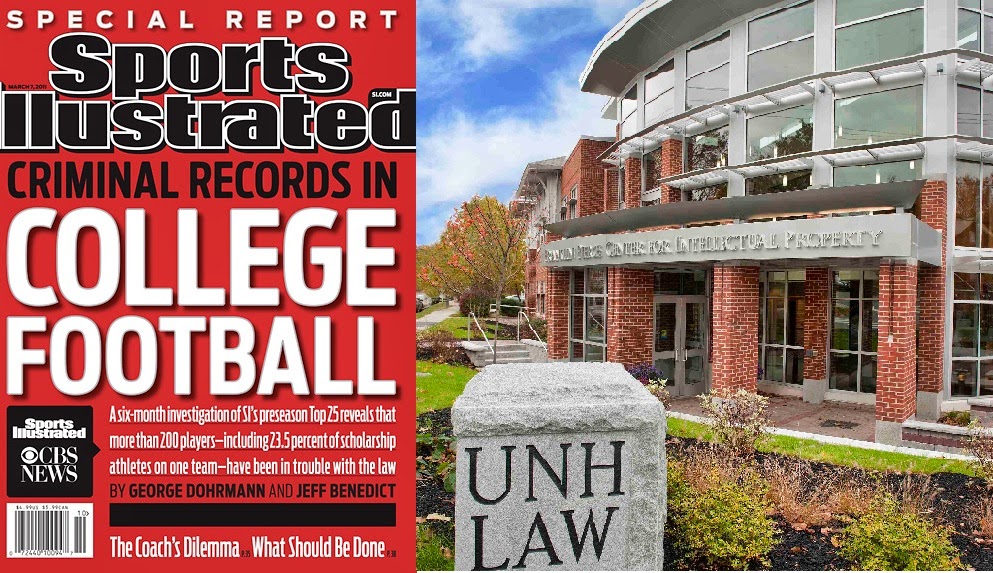Recently published scholarship includes:
Gregory T. Dziura, Note, Playing the Tax Court hazard: Retief Goosen’s tax case and taxation of nonresident aliens, 40 SYRACUSE JOURNAL OF INTERNATIONAL LAW AND COMMERCE 379 (2013)
Marc Edelman, Closing the “free speech” loophole: the case for protecting college athletes’ publicity rights in commercial video games, 65 FLORIDA LAW REVIEW 553 (2013)
Adam Epstein & Henry Lowenstein, Promises to Keep? Coaches Tubby Smith, Jimmy Williams and Lessons Learned in 2012, 24 SOUTHERN LAW JOURNAL (2013)
Anthony Paul Farley, The bitter tears of Jesse Owens, 22 BERKELEY LA RAZA LAW JOURNAL 231 (2012)
Gabe Feldman, Closing the floodgates: the battle over workers’ compensation rights in California, 8 FIU LAW REVIEW 107 (2012)
Daniel Gandert and Esther Kim, The NFL’s headache: issues with California workers’ compensation for continuous head traumas in former professional football players, 45 UNIVERSITY TOLEDO LAW REVIEW 57 (2013)
Daniel Gandert et al., The intersection of women’s Olympic sport and intersex athletes: a long and winding road, 46 INDIANA LAW REVIEW 387 (2013)
Robert John Givens, Comment, “Capitamateuralism”: an examination of the economic exploitation of student-athletes by the National Collegiate Athletic Association, 82 UMKC LAW REVIEW 205 (2013)
Drew N. Goodwin, Note, Not quite filling the gap: why the miscellaneous expense allowance leaves the NCAA vulnerable to antitrust litigation, 36 B.C. INTERNATIONAL AND COMPARATIVE LAW REVIEW 1277 (2013)
William B. Gould, IV, Football, concussions, and preemption: the gridiron of National Football League litigation, 8 FIU LAW REVIEW 55 (2012)
Zachary A. Greenberg, Note, Tossing the red flag: official (judicial) review and shareholder-fan activism in the context of publicly traded sports teams, 90 WASHINGTON UNIVERSITY LAW REVIEW 1255 (2013)
Dena Guttmann, Note, Dear Olympic medalists, thank you for representing our country in the Olympics,but it’s time to pay up!, 22 CARDOZO JOURNAL OF INTERNATIONAL AND COMPARATIVE LAW 85 (2013)
Adam Herschthal, Note, From rats to riches: how the Anabolic Steroid Control Act of 2004 unjustly punished the gym rat and how a new prescription is the road to salvation, 63 SYRACUSE LAW REVIEW 437 (2013)
William B. Gould, IV, Football, concussions, and preemption: the gridiron of National Football League litigation, 8 FIU LAW REVIEW 55 (2012)
Zachary A. Greenberg, Note, Tossing the red flag: official (judicial) review and shareholder-fan activism in the context of publicly traded sports teams, 90 WASHINGTON UNIVERSITY LAW REVIEW 1255 (2013)
Dena Guttmann, Note, Dear Olympic medalists, thank you for representing our country in the Olympics,but it’s time to pay up!, 22 CARDOZO JOURNAL OF INTERNATIONAL AND COMPARATIVE LAW 85 (2013)
Adam Herschthal, Note, From rats to riches: how the Anabolic Steroid Control Act of 2004 unjustly punished the gym rat and how a new prescription is the road to salvation, 63 SYRACUSE LAW REVIEW 437 (2013)



